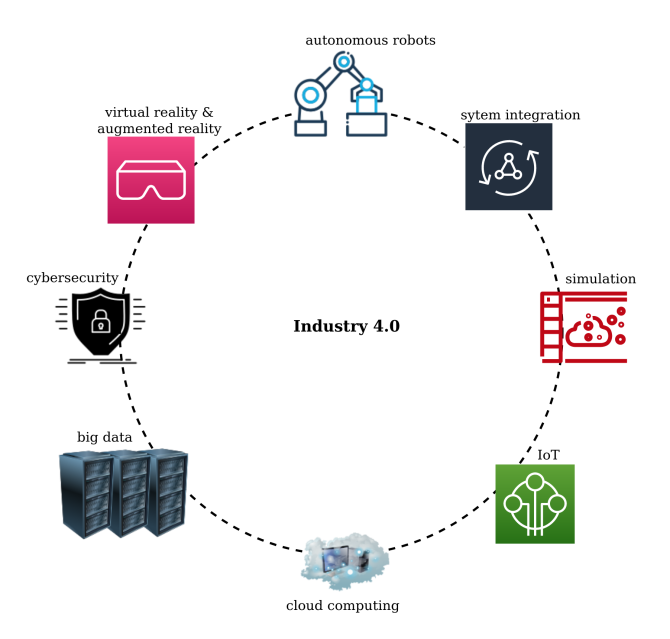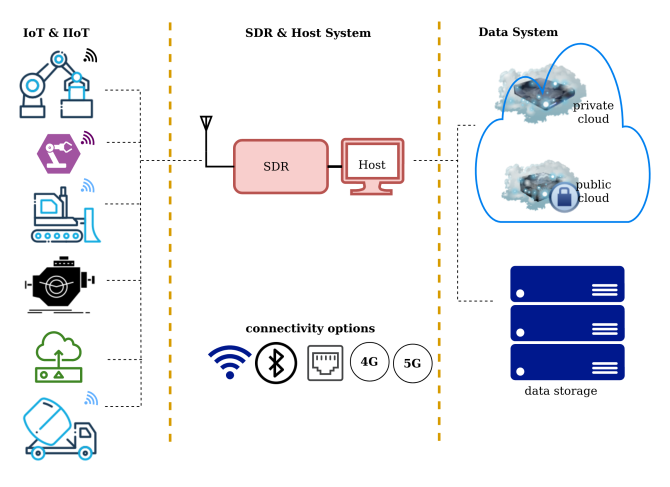
SDRs solve IIoT industrial systems
By Brendon McHugh, field application engineer & technical writer at Per Vices
Electronics Engineering IoT AOI systems Editor Pick IIoT industrial platform SDR systemsSoftware defined radios reduce frequency hopping, incompatibility of standards
Introduction
The Industrial Internet of Things (IIoT) is gradually revolutionizing communication infrastructure in industry, as wireless systems are increasingly replacing wired solutions in various industrial systems. IIoT systems require low latency and tight synchronization to run, and often integrate software defined radio (SDR) to hit these technical requirements.
This article discusses the various capabilities of SDR systems that make them suitable for implementing IIoT solutions, including wide tuning range, high bandwidth, multiple-input multiple-output (MIMO), and low latency performance. SDRs also help to solve various issues in industrial environments, such as frequency hopping, incompatibility of standards, inflexibility of wireless/networking equipment, and more.
IIoT ecosystem
IIoT is one of the key enabling technologies for Industry 4.0 – which entails use of data-driven assembly and production and massive use of sensors for data acquisition and network monitoring. This level of connectivity requires hybrid wireless sensor networks that are capable of interconnecting various devices including programmable logic controllers (PLCs), sensors and actuators. Figure 1 shows some of the technologies that enable Industry 4.0 and IIoT.
Connectivity in conventional industrial environments is dominated by wired networks, however, most industries are switching to wireless infrastructure mainly because of their quick configuration, higher mobility, and lower cost of installation and maintenance.

Source: Per Vices
In addition to connectivity, quality control and productivity are critical issues in today’s industries. IIoT employs smart devices and autonomous systems to enhance flexibility and efficiency in manufacturing processes. Moreover, IIoT systems feature a variety of analytics tools that provide real-time insights required to enhance business agility. This allows for employees to monitor and assess production and make modifications if necessary for supply and demand, specifications, and other parameters.
The growth of Internet of Things (IoT) has helped to accelerate adoption of wireless sensor networks (WSNs) in a variety of industrial applications including remote control, environmental monitoring, telecommunication, and disaster detection. IIoT devices utilize a wide range of non-interoperable wireless links and protocols. These standards include Long Range (LoRA), Wi-Fi, Sigfox, 2G, 3G, Ingenu, Weightless, ZigBee, WirelessHART, and Bluetooth Low Energy (BLE). As these standards evolve and advance in capability, the ability for radio and networking systems to adapt will be paramount to the success of IIoT implementations.
SDR systems
A typical SDR platform features a radio front-end (RFE) and a digital backend. The RFE features transmit (Rx) and receive (Rx) functions and offers a broad tuning range, typically 0-18 GHz. The tuning range of best performance SDR systems can be extended up to 40GHz. Furthermore, the highest bandwidth SDR systems can offer an instantaneous bandwidth of 3GHz.
The backend of an SDR platform features a field programmable gate array (FPGA) with a broad range of onboard DSP capabilities including modulation, upconverting and demodulation. The reconfigurability of these modules enables implementation of new radio protocols and digital signal processing (DSP) algorithms, which allows for flexibility and ability to keep up with technological advances.
SDR platforms feature multiple Tx and Rx channels, with each of these independent channels featuring dedicated analog-to-digital converters (ADCs) and digital-to-analog converters (DACs). Furthermore, high performance SDR platforms support a broad array of open source tool kits, such as GNU radio.

Source: Per Vices
SDR platforms vary in size and complexity to meet the diverse needs of today’s applications. The modular architecture of SDR systems allows more devices to be added by simply increasing the number of channels and allows for systems to be linked together for larger projects. This makes an SDR platform a cost effective solution for implementing scalable industrial solutions, such as ultra-high network backhaul systems.
SDRs for IIoT applications
One of the main challenges facing the realization of IIoT is incompatibility due to the lack of a unifying technology that can work with a broad array of standards; often which are evolving regularly. The flexibility and reconfigurability of SDR systems enable them to seamlessly support a wide variety of wireless technologies. Moreover, the performance characteristics of SDR systems make them suitable for implementing a broad range of industrial solutions including data aggregators, base stations, and cloud and data center gateways.
Various SDR-based IIoT solutions have been implemented and have their performance tested to ensure successful operation before full-scale deployment. Tests with a prototype system, which was developed for routing data to and from a variety of IIoT devices utilizing different wireless protocols, such as ZigBee, LoRA, and BLE [1], have shown that these platforms are suitable for developing highly scalable gateways. The solution utilized MQTT broker to enable IP-based packet transmission. Figure 2 shows an IIoT gateway developed using an SDR system.
Some of the key parameters to consider when selecting an SDR system for IIoT applications include power, sensitivity, selectivity and phase noise. The range of an RF system is significantly determined by the power of the transmitter and the sensitivity of the receiver. Careful consideration is required since authorities restrict the maximum power that can be transmitted and high power transmission devices are usually expensive.
For instance, one particularly important parameter is the ability of a receiver to distinguish between a signal of interest and an unwanted signal, which is determined by its sensitivity. Another related parameter is the capability of a system to receive a signal of interest when an unwanted signal is active in an adjacent channel is described in terms of adjacent channel rejection (ACR).
To achieve high blocking and selectivity figures, it is vital to ensure that the phase noise in the radio system is minimal. Phase noise is caused by short-duration fluctuations in a radio signal and is typically measured in dBc/Hz relative to the carrier. Minimizing phase noise induced by oscillators/synthesizers in a radio system is essential, particularly one’s that are subject to vibration other disturbances in an industrial environment.
The resilience of a receiver to nearby high power sources of interference is mainly determined by its front-end linearity. The linearity of a receiver is usually given in terms of input third-order intercept (IIP3). This is critical in IIoT settings, where densely packed transmitters and power supplies are often causing interference among one another.
How SDRs are solving IIoT challenges
SDR platforms offer high flexibility and can support a wide range of wireless technologies, making them particularly suitable for use in applications involving real-time acquisition and transmission of data. In addition, an SDR platform can operate over a broad range of frequencies, allowing one unit to replace many separate ones that operate over limited frequencies.
SDRs allow control and data links to be easily adapted to meet the conditions of a radio system. This means that parameters such as gain, error correction codes, and filtering methods can be adaptively adjusted. Furthermore, the high flexibility of SDR systems allows wireless links to be configured individually depending on the operating conditions (for instance, meeting environmental standards including vibrations and temperature).
One of the techniques that are commonly used to avoid interference is frequency hopping, which is the repeated switching of carrier frequency during transmission to reduce interference and avoid interception. SDRs support frequency hopping and a variety of modulation schemes used in an IIoT environment
There is a new SDR design that utilizes FPGA instead of a general-purpose computer. This model-based architecture allows the system to perform fast signal processing and is particularly suitable for time-critical applications. Moreover, use of software-based modules in SDRs helps to shorten the cycle of developing and evaluating new radio techniques.
Integrating an SDR system with software defined network (SDN) technology enhances network management functions and enables security and resource orchestration. This combination also offers high immunity to latency-related problems and is therefore suitable for time-critical applications. In addition, SDN is capable of reconfiguring a network to real-time predefined requirements thereby helping to enhance the reliability of wireless communication systems.
In addition, SDR systems can be used for assessing the performance characteristics of wireless networks. A prototype solution that utilizes SDR technology and Precision Time Protocol (PTP) was developed to measure time-related metrics [2]. Tests with this prototype showed that it was capable of providing precise measurements of jitter and time delay.
Conclusion
SDRs offer unique capabilities that make them particularly suitable for implementing IIoT solutions. These capabilities include a wide tuning range, MIMO channels, and reconfigurability. SDRs are capable of supporting a wide variety of wireless protocols used in IIoT applications and their reconfigurability enables easy implementation of new protocols and algorithms, which are integral in adapting to new technology and innovations. Furthermore, combining SDR and SDN technologies enables realization of robust low-latency radio solutions for numerous IIoT applications by functioning as a gateway for different low-power radio protocols.
———————
Author Information

Brendon McHugh is a field application engineer & technical writer at Per Vices.
Brendon McHugh is a field application engineer & technical writer at Per Vices. Simon Ndiritu is an electrical engineer & technical writer. Per Vices offers high performance SDR solutions that are suitable for various IIoT applications.

Simon Ndiritu is an electrical engineer & technical writer.
